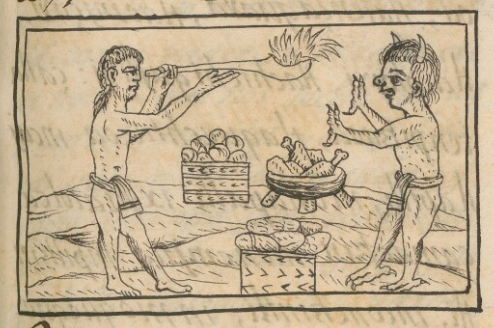tlacatecolotl (FCbk6f28r)
This iconographic example featuring a figure that is part human and part horned owl (tlacatecolotl) is included in this digital collection for the purpose of making comparisons with related hieroglyphs. The term selected for this example comes from the keywords chosen by the team behind the Digital Florentine Codex. There is no gloss. The figure stands, wearing only a loincloth. He has two curving horns on his head, suggesting European religious influence had pushed his look toward that of a demon or devil. His mouth is open and his nose is large, possibly pierced or wearing an ornament. As the contextualizing image shows, the tlacatecolotl reaches forward with his front claws, seemingly threatening a Nahua priest who holds a large censer with fire in the bowl (apparently a tlemaitl) as though to ward off the threat. The two figures are standing on dirt, facing one another. Between them are offerings, such as a basket of tamales and a tripod bowl with meat on bones.
Stephanie Wood
The original meaning of tlacatecolotl got lost fairly early in Nahuatl texts, given that the friars fastened onto that term to mean demon or devil and inculcated that interpretation into their Nahua students and parishioners. The two Nahuatl hieroglyphs for Tlacatecolotl (a personal name!) that are shown below resemble a horned animal more than an owl, even if the name translates as human-horned owl. We include a couple of examples of owl glyphs below, too. Owls’ eyes can give an impression of the supernatural. In one of the attestations for the term tlacatecolotl in our Online Nahuatl Dictionary a Nahua from Amecameca said that a tlacatecolotl he saw resembled a monkey. We include a monkey that may have a supernatural look, too.
Stephanie Wood
1577
Jeff Haskett-Wood
diablo, diablos, demonio, demonios, Hechicero, hechiceros, cuernos, garras, taparrabo
tlacatecolo(tl), human-horned owl, sorcerer, or devil (through colonial influences), https://nahuatl.wired-humanities.org/content/tlacatecolotl
el humano-tecolote
Stephanie Wood
Available at Digital Florentine Codex/Códice Florentino Digital, edited by Kim N. Richter and Alicia Maria Houtrouw, "Book 6: Rhetoric and Moral Philosophy", fol. 28r, Getty Research Institute, 2023. https://florentinecodex.getty.edu/en/book/6/folio/28r/images/0 Accessed 3 July 2025.
Images of the digitized Florentine Codex are made available under the following Creative Commons license: CC BY-NC-ND (Attribution-NonCommercial-NoDerivs 4.0 International). For print-publication quality photos, please contact the Biblioteca Medicea Laurenziana ([email protected]). The Library of Congress has also published this manuscript, using the images of the World Digital Library copy. “The Library of Congress is unaware of any copyright or other restrictions in the World Digital Library Collection. Absent any such restrictions, these materials are free to use and reuse.”







